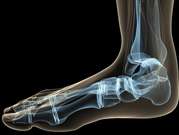Quality of cartilage repair tissue can also be determined without a surgery

A team at the MedUni Vienna, headed by Sebastian Apprich of the University Department of Radiodiagnostics at the High-Field Magnetic Resonance Centre of Excellence, has now discovered in collaboration with the University Department of Orthopaedics that the quality of cartilage tissue can also be determined without an invasive procedure: with the assistance of diffusion weighted imaging in a 3-Tesla scanner cartilage quality can be assessed in a much less invasive way.
The surgical treatment of cartilage defects is a comparatively young research field. Different surgical methods have developed in the last few years, nevertheless in specialist orthopaedic circles there is no unanimously held opinion on the best form of treatment. Also playing a part in the long-term post-operative result, and thus the wellbeing of the patient, is the quality of the newly created cartilage repair tissue. These days a biopsy, and hence another surgical intervention, is necessary in order to be able to assess this definitively.
At the High-Field Magnetic Resonance Centre of Excellence, under the leadership of Siegfried Trattnig, scientists have been working on the development of non-invasive examination methods for years, in order to image quantitatively the individual components, and thus the quality of the joint cartilage. Says Apprich: "We concerned ourselves with questions such as "What is the water content like?" "What does the collagen fibre structure look like?" "How high is the proteoglycan content?" These are all components of joint cartilage contributing decisively to its unique function.
In their current work, the scientists have examined the two most common surgical methods at the present time for cartilage defects in the ankle joint. The more time-consuming and costly method consists in the removal of cartilage cells, then cultivating and reproducing them in the laboratory followed by a re-implantation in the defect. The other method, the so-called bone marrow stimulating method, consists of drilling a hole in the underlying bone, similar to a sieve. The blood seeping out of these holes forms a blood sponge in the defect and, over the course of time, cartilage repair tissue is reconstructed.
With the help of diffusion weighted imaging the scientists were able to prove statistically significant differences in the ultrastructure of the cartilage repair tissue after these two different operation methods, whilst the usual morphological and clinical examinations showed no difference.
Says Apprich: "With the diffusion weighted imaging we were able to show that, after the more time-consuming cartilage cell transplantation, the cartilage repair tissue was more like the normal, healthy hyaline joint cartilage than that after the bone marrow stimulating method."
According to the scientist, another application possibility for this special imaging technique lies of course in the preventive evaluation of joint damage, which, in future, could play a decisive role in the treatment of osteoarthritis given the very limited regenerative capacity of cartilage.
More information: Journal of Osteoarthritis and Cartilage, “Assessment of articular cartilage repair tissue after matrix-associated autologous chondrocyte transplantation or the microfracture technique in the ankle joint using diffusion weighted imaging at 3Tesla.” S. Apprich, et al. www.ncbi.nlm.nih.gov/pubmed/22445916


















